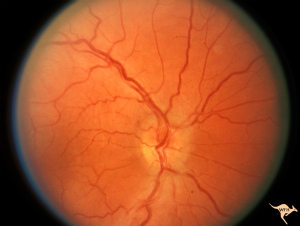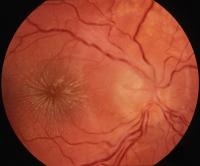|
LCA Leber Eye Disease
There are multiple eye diseases that were originally described by the German ophthalmologist Theodor Leber, M.D. and which are consequently referred to as Leber Eye Disease. Below are four clinical entities that bear the name. LCA Leber Eye Disease is an inherited cause of blindness in the first year of life. It is the most early and severe form of all inherited retinal dystrophies. LCA is usually an autosomal recessive condition marked by a single-gene defect that prevents the retina from producing the proteins that play a vital role in maintaining the health of the eye’s light receptors. Ten genes have been found by researchers to cause 70 percent of all cases of LCA. More research is needed to discover which gene or genes cause the other 30 percent of cases. It is possible that a non-genetic condition may mirror LCA. Regardless, pedigree analysis and genetic counseling are important. Until recently, the chances for visual recovery were very poor. The diagnosis is generally made at birth or during the first months of life in an infant with total blindness or greatly impaired vision, normal fundus and extinguished electroretinogram (ERG). ERG is an objective measurement of retinal function. The affected person also has a tendency to poke at his or her eyes (digito-ocular sign) and often has accompanying neurological disorders, mental retardation, and other eye findings. There may also be a higher prevalence of sleep disorders in blind children than in those that are sighted.
What are signs and symptoms of LCA?
A child with LCA Leber Eye Disease usually presents with the following symptoms in the first year of life: Is there any hope for LCA?
There is a ray of hope for those afflicted with LCA in the form of gene therapy. A recent study was done on LCA Leber Eye Disease patients in whom a virus carrying copies of the healthy gene is injected near the eye’s retinal pigment epithelium. The virus invades the cells, which convert the new genes into the proteins that supply the light receptors with the Vitamin A necessary to form the pigment that absorbs light and allows the person to see. The study showed promising results in twelve patients, with six no longer being considered legally blind. The current status of this potential treatment is three to five years for Food and Drug Administration (FDA) approval. Are you a young male who has experienced rapid, often severe loss of vision? The loss of vision may have begun in one eye but then began happening to the other eye? You may have Leber’s Hereditary Optic Neuropathy (LHON). What is LHON?
LHON is a hereditary Leber Eye Disease marked by Optic Nerve Atrophy. Researchers have discovered that the genetic factor is a mitochondrial DNA mutation transmitted by the mother. Mitochondria are bodies within cells responsible for producing energy from oxygen within the cells where energy is required to perform the activities of the cells. Studies have shown that there are some twenty different genes known to take part in the development of LHON. What exactly causes the mitochondria in optic nerve cells to be unable to produce the necessary energy and result in cell death is unknown. Some speculate that cell death is programmed, and is the consequence of a random distribution of defective mitochondrial DNA during the normal cell division and aging process of cells. What are the signs and symptoms of LHON?
Symptoms of LHON Leber Eye Disease include: Signs of LHON Leber Eye Disease include: As the condition progresses, the optic atrophy results in: 
How is LHON treated and managed?
Unfortunately, as holds true with many hereditary diseases, there is no effective treatment for LHON. Japanese investigators in the late sixties reported favorable results of craniotomy followed by weekly intrathecal (under the space of the arachnoid membrane of the brain) injections of vitamins B1, B2 and B12. The results, however, seem to have been debunked by studies done in the Netherlands. Still, vitamin therapy is used in the treatment of LHON Leber Eye Disease because it cannot create a problem and it may be beneficial. Your eye doctor can best help you by giving you an optimal prescription and providing or referring you for Low Vision rehabilitation. Your eye doctor will recommend genetic counseling keeping in mind that the following key points: Your doctor may also consider giving you a cardiology consult because of increased risk of cardiac conduction defects. As more is learned about the causative mechanism of LHON Leber Eye Disease, it may be reasonable to focus on prevention. There are toxic substances which have been associated with neurological damage and optical blindness. It is possible that if you have genetic deficiency of the mitochondria you may be more susceptible to even small exposures to these substances. Avoidance of toxic substances is recommended if at all possible along with judicious use of antioxidants when exposure is unavoidable. Examples of such toxic substances include: Have you experienced sudden vision loss? The loss of vision may have begun after a viral illness causing either upper respiratory, gastrointestinal, or genitourinary symptoms. If your eye doctor tells you that your optic nerve is swollen, you may have Leber’s Idiopathic Stellate Neuroretinitis (LISN). What is LISN?
LISN is an uncommon Leber Eye Disease of unknown cause. Half of all patients affected have symptoms of a viral illness. Studies have revealed that LISN affects both eyes in only 7 to 33% of cases. The average age of LISN patients ranges from 22 to 30 years, although LISN has been reported in individuals 8 to 55 years of age. Signs and Symptoms of LISN Leber Eye Disease include: 
How is LISN diagnosed, treated and managed?
Culture results for LISN Leber Eye Disease are often negative and visual recovery usually occurs. Notwithstanding, since severe infectious diseases which are potentially vision- and even life-threatening have been reported in association with LISN, your eye doctor has to carefully consider these conditions before making the diagnosis of LISN. Some of the diseases that must be considered include cat-scratch fever, leptospirosis, peripheral idiopathic seventh nerve palsy (Bell’s palsy), chickenpox, influenza, Salmonella typhi infection, mumps, trauma, and multiple sclerosis. Are you a young person with a Leber Eye Disease marked by dilated blood vessels and aneurysms in the Retina of one eye? You may have a condition referred to as Leber Miliary Aneurysm. Leber Miliary Aneurysm is a rare condition believed to be a mild form of Coat’s disease. If you have this type of Leber Eye Disease, you are likely to be male and younger, with most diagnoses occurring between the ages of 18 months and 18 years. Often, you may have no symptoms and the condition is found during a routine eye examination. However, if you have an advanced case, the vision may be greatly reduced. Unlike Coat’s disease, Leber Miliary Aneurysm has minimal hemorrhage and leaking of blood vessels. The cause of this Leber Eye Disease is unknown. Because this milder form of Coat’s disease is largely asymptomatic, it contributes to the prime reason why eye doctors should routinely dilate young asymptomatic patients. |




